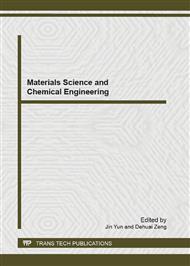[1]
Dj.M. Maric, P.F. Meier and S.K. Estreicher: Mater. Sci. Forum Vol. 83-87 (1992), p.1191 W. Zhang, C. Y. Cheng: Hydrometallurgy, 89 (2007) , p.137
Google Scholar
[2]
T. Q. Li: China's manganese industry, 56 (2008) , p.4 (in Chinese)
Google Scholar
[3]
S. C. Das, P. K. Sahoo, P. K. Rao: Hydrometallurgy, 8 (1982), p.35
Google Scholar
[4]
C. Abbruzzese: Hydrometallurgy, 25 (1990) , p.85
Google Scholar
[5]
D. Hariprasad, B. Dash, M. K. Ghosh, S. Anand : Minerals Engineering, 20 (2007) , p.1293
Google Scholar
[6]
C. Acharya, R. N. Kar: Minerals Engineering, 16(2003), p.1027
Google Scholar
[7]
T. Jiang, Y. B. Yang, Z. C. Huang, G. Z. Qiu: Hydrometallurgy, 69 (2003), p.177
Google Scholar
[8]
A. A. Ismail, E. A. Ali, I. A. Ibrahim, M. S. Ahmed: Can. J. Chem. Eng., 82 (2004), p.1296
Google Scholar
[9]
M. Trifoni, F. Veglió, G. Taglieri, L. Toro: Miner. Eng., 13 (2000), p.217
Google Scholar
[10]
M. Trifoni, L. Toro, F. Veglió: Hydrometallurgy, 59 (2001), p.1
Google Scholar
[11]
F. Pagnanelli, M. Garavini, F. Vegliò, L. Toro: Hydrometallurgy, 71 (2004), p.319
Google Scholar
[12]
F. Pagnanelli, M. Garavini, F. Vegliò, L. Toro: Hydrometallurgy, 75 (2004), p.157
Google Scholar
[13]
G. Furlani, F. Pagnanelli, L. Toro: Hydrometallurgy, 81 (2006), p.234
Google Scholar
[14]
H. F. Su, H. K Liu, F. Wang, X. Y. Lü, Y. X. Wen: Chin. J. Chem. Eng., 18 (2010), p.730
Google Scholar
[15]
H. F. Su, Y. X. Wen, F. Wang, X. H. Li, Z. F. Tong: Miner. Eng., 22 (2009), p.207
Google Scholar
[16]
T. A. Lasheen, M. N. El Hazek, A. S. Helal: Int. J. Miner. Process, 92 (2009), p.109
Google Scholar
[17]
X. K. Tian, X. X. Wen, C. Yang, Y. J. Liang, Z. B. Pi: Hydrometallurgy, 100 (2010), p.157
Google Scholar
[18]
Z. Cheng, G. C. Zhu, Y. N. Zhao: Hydrometallurgy, 96(2009), p.176
Google Scholar
[19]
J. J. Song, G. C. Zhu, P. Zhang, Y. N. Zhuo: Acta Metall. Sin.(Engl. Lett.), 23(2010), p.223
Google Scholar
[20]
V. S. Batra, S. Urbonaite, G. Svensson: Fuel, 87 (2008), p.2972
Google Scholar
[21]
S. J. Ren: Wuhan Industry University Press, Wuhan, (1993)
Google Scholar
[22]
F. W. Y. Momade, Zs. G. Momade: Hydrometallurgy, 54 (1999), p.25
Google Scholar
[23]
S. B. Kanungo, S. K. Mishra: Trans. Indian institute of metals, 55(3) (2002), p.81
Google Scholar
[24]
C. Fushimi, K. Araki, Y. Yamaguchi, A. Tsutsumi: Ind. Eng. Chem., 42 (2000), p.3929
Google Scholar


